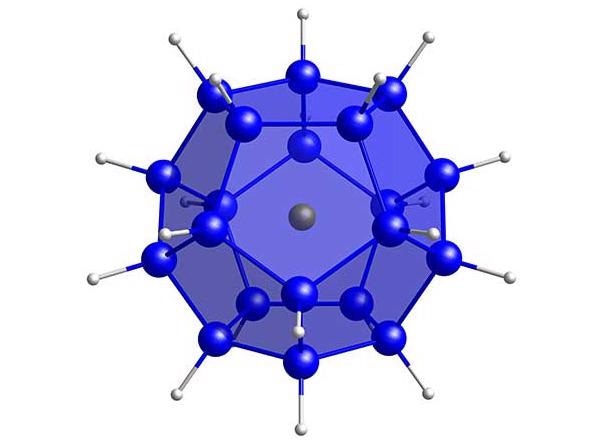Sep 9 2021Reviewed by Alex Smith
At the Goethe University in Frankfurt, chemists have developed two new groups of nanomaterials and analyzed them in association with collaborators from the University of Bonn.

The silicon sphere [Cl@Si20H20]−, synthesized for the first time by chemists from Goethe University Frankfurt, promises new applications in semiconductor technology. Blue: silicon; green: chloride ion; grey: hydrogen. Image Credit: Goethe University Frankfurt.
The researchers, for the first time, successfully developed a nanosphere of silicon atoms and a building block for diamond-like crystals of the semiconductor elements germanium and silicon.
The two new classes of materials can be applied for the miniaturization of computer chips, high-resolution screens for smartphones and solar cell and light-emitting diodes with the maximum levels of efficiency.
The latest generation of computer chips measure only a few nanometers in size and are turning to be more energy-saving and powerful as a result of progressive miniaturization. The etching processes conventionally used in chip production are reaching their limits. Therefore, the development of new, nanostructured semiconductor materials becomes necessary. They are also key to convert electricity into light and vice versa.
The research team led by Matthias Wagner has successfully synthesized molecular nano “sphere” developed with 20 silicon atoms known as silafulleranes. The second new class of materials is crystal building blocks developed from 10 silicon and germanium atoms that have a diamond-like structure. Strong insights into the electronic structures of the new compounds were offered by the computer-based theoretical studies from Stefan Grimme’s research group in Bonn.
The 20 silicon atoms of silafullerane tend to form a dodecahedron, which is a body comprising regular pentagons. The body encloses a chloride ion. A hydrogen atom protrudes outward at each silicon corner of the body.
Our silafullerane is the long-sought progenitor of this new class of substances. The hydrogen atoms can easily be replaced with functional groups, thus giving the silafullerane different properties.
Marcel Bamberg, Doctoral Student, Goethe University
Bonn quantum chemist Markus Bursch added, “We support the targeted generation of potentially useful properties with theoretical predictions of their resulting effects.” The silicon-germanium adamantane denotes the building block of a silicon-germanium alloy mixture.
According to Benedikt Köstler, who is developing the compounds as part of a doctoral thesis, “Recent studies have shown that silicon-germanium alloys are superior to pure silicon semiconductors in important application areas. However, the production of such alloys is very difficult and you often get mixtures of different compositions. We have succeeded in developing a simple synthesis path for the basic building block of silicon-germanium alloys.”
Our silicon-germanium adamantane therefore enables the investigation of important chemical and physical properties of silicon-germanium alloys on the molecular model. We also want to use it in the future to produce silicon-germanium alloys with faultless crystal structures.
Benedikt Köstler, Goethe University
Carbon chemically resembles silicon and germanium, and occurs in a similar form to the two new classes of substances: Hollow spheres of carbon atoms (“fullerenes”) correspond to silafulleranes, and diamonds comprising carbon are composed of adamantane subunits.
When compared to other things, fullerenes raise the efficiency of organic solar cells, making the batteries of electric cars safer and guarantee advancement in high-temperature superconductivity. Nanodiamonds also have a broad range of applications starting from pharmaceuticals to catalysis research.
Regarding these scenarios, the researchers in Frankfurt and Bonn are awaiting to witness the sectors in which silafulleranes and silicon-germanium adamantanes will find applications.
It is already possible to generate light in all colours of the visible spectrum with nanostructured silicon and germanium in the form of quantum dots, and this is being tested for computer and mobile phone displays, as well as in telecommunications. Apart from the chemical-technical potential, I am personally fascinated by the high symmetry of our compounds: For example, our silafullerane is one of the five Platonic solids and possesses a timeless beauty.
Matthias Wagner, Goethe University
Journal Reference:
Koestler, B., et al. (2021) Selective One-Pot Syntheses of Mixed Silicon-Germanium Heteroadamantane Clusters. Chemistry—A European Journal. doi.org/10.1002/chem.202102732.
Source: https://www.goethe-university-frankfurt.de/en?locale=en